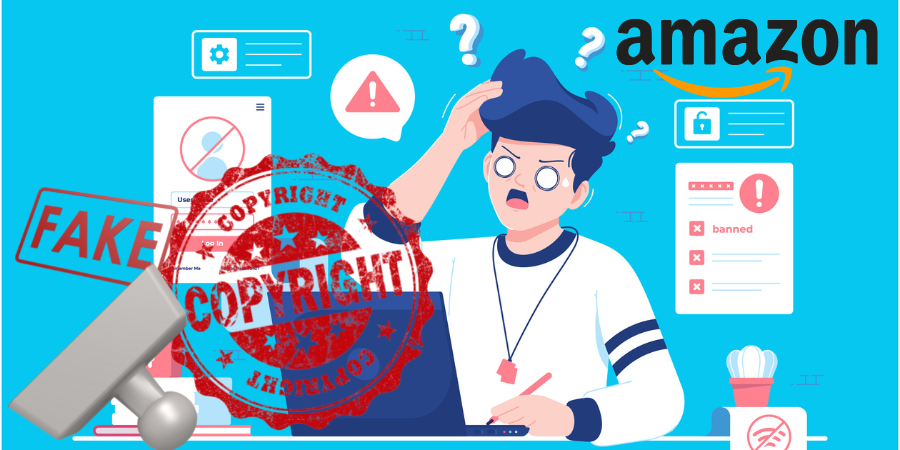How a Sophisticated Amazon Scam Destroys a Successful Business

Over the past decade or so, plenty of entrepreneurs have discovered Amazon’s golden mine, enabling thousands of them to build big businesses and make a pile of money in the process. We keep hearing about Amazon businesses selling for millions of dollars and in some cases hundreds of millions.
Unfortunately, like all others, Amazon’s coin has two sides. The flip side of Amazon’s success can be as painful for the entrepreneur involved as it can be eye-opening for the outside observer. Many hidden dangers are lurking in Jeff Bezos’ online emporium, any one of which can sink your entrepreneurial ship in the blink of an eye.
Ask any Amazon seller what his or her biggest fear is, and the invariable answer you will receive is account suspension. Amazon’s terms of service are a seemingly interminable list of reasons for which your account could be suspended. Still, in reality, it can happen for anything their bots decide they don’t like. And once a bot flags your account, good luck explaining to a human employee why your account should be reinstated.
Just today, your correspondent came across a perfect case in point for the absurdity, which, unfortunately, is the reality Amazon sellers are forced to deal with on a daily basis. A successful Amazon seller has been successfully targeted by scammers in a sophisticated operation, which ended with the suspension of the seller’s account and the effective destruction and eventual bankruptcy of their business. Here is how it happened. Please note that I will not disclose sensitive seller details to protect them from retribution and will focus instead on the scam.
The Beginning of a Successful Amazon Business
This Amazon journey began in early 2018 with a product, that this entrepreneur had spent a lot of time designing. They took the extra and very costly step of patenting their product’s design before launching its first version a year and a half later.
The product was unique and evidently well-made, making it an instant success and prompting thousands of satisfied customers to leave five-star reviews from the beginning. Within a few months, this first product became Amazon’s best-seller in one of the most competitive categories, receiving a total of more than 30,000 reviews with an astonishing average rating of 4.8 stars.
Amazon Success Attracts Envy
And just when this entrepreneur’s first product seems destined for a world-conquering tour, a storm begins to gather. As every Lord of the Rings fan knows, success and happiness attract envy and malice, and this story, it turns out, confirms Tolkien’s wisdom.
About a year and a half after the successful launch, a new player enters this very competitive market, in which the top 15 sellers had accumulated more than 15,000 reviews on each. Good luck breaking in, right?
Well, this particular newcomer is not your garden variety novice and has developed a solid strategy to ensure its success, using whatever means necessary and inflicting as much pain on their rivals as they can manage.
First, the newcomer, let’s call them Gollum, files a fake copyright complaint, causing the suspension of the great product our successful entrepreneur, let’s call them Frodo, spent so much time, money, and labor developing.
Now, as everyone who has even the vaguest idea how Amazon’s seller support system works, a suspension is a big deal. They ask you to provide all kinds of documents to prove all kinds of things related to the validity of your business and products, some of which you could guess, but most of which you could never think of. And to top it off, the review process is seldom a short, straightforward one.
In this case, it takes Frodo three weeks to reinstate his product, losing thousands upon thousands of sales in the process and suffering a huge plunge in Amazon’s search results in the process. So, on top of the sales, he lost in those three weeks of inactivity, Frodo is effectively punished with the loss of many more sales in the weeks and months to come because his product is now virtually invisible, buried under all of his competitors’ products.
To add insult to injury, Gollum’s product manages to become the best seller in the whole subcategory in a single day, a seeming impossibility, considering that its best seller rank (BSR), a measure of how well a given product sells in comparison to the rival products, is much lower than its competitors’. So how is Gollum doing it?
The Make-Up of an Amazon Scam
After some basic research, Frodo discovers that Gollum has used a disposable, secondary seller account to hijack a competitor’s listing (which is a different can of worms, best left for another day). Having thus secured a toehold in the target category, Gollum puts the second part of his malicious scheme in motion by offering a huge discount to anyone who buys his product.
To find willing buyers, he turns to specialized Facebook groups, populated with users looking for free products (or as close to free as makes no difference). Overnight, Gollum starts “selling” 5,000 – 6,000 items a day, and he is deep-pocketed enough to be able to sustain these losses for a week (keep in mind that each such “sale” costs Gollum not just the cost of the product itself, but all the fees Amazon for each sale, as well as his shipping and handling costs).
But wait, Gollum actually doesn’t pay any shipping and handling costs, even though he is not using Fulfilled by Amazon (FBA), which does that for sellers, but has opted to do it himself. And that’s why he is using a disposable seller account: he gets the orders, but doesn’t ship any of them.
Of course, Amazon will eventually shut this account down, and does, but that’s OK. By the time the disposable account is gone, Gollum’s product tops the search results, and his main account is now activated and using FBA. Sales start pouring in, but Gollum isn’t done yet… Not by a long shot.
Making Sure Your Rival’s Account Remains Penalized
To ensure that his rival never gets a chance to recover, Gollum keeps kicking him while he’s down by continually filing fake complaints against him, of various kinds. He begins by starting to tag Frodo’s product as an adult (sex toys), causing his competitor to be deindexed (and out of the picture) for more than a week at a time.
Every time Frodo’s product is suspended, Gollum’s sales receive another fillip and, for best results, he files his fake complaints just as often as he can. For the sake of variety, Gollum uses the full spectrum of Amazon’s list of forbidden activities:
- Fake copyright claims — it takes more than a week for Amazon to reinstate the product following such a suspension.
- Fake variation abuse reports — this one is also subject to another day, but it takes about a week to recover from.
- Fake infringement and restricted keyword complaints. This is another subject for another day, but for today’s purposes, it would suffice to say that a certain type of account, called a vendor account, allows its owners to edit listings that do not belong to them. Naturally, Gollum has equipped himself with such an account and is gleefully adding “restricted” keywords to Frodo’s listing, causing suspensions that take about a week to recover.
- Changing a product’s attribute type to adult (sex toys) — as we saw, it can take a week or longer to recover from such a suspension.
Note that this is not a complete list of suspension types.
Keeping His Sales Up
Not content with Frodo’s misfortune, Gollum bolsters his success by starting to offer a payment to every buyer who is willing to leave a five-star review for his product. And the payment in question is about half the amount the buyer has paid for the product, so many buyers take Gollum up on his offer. Consequently, Gollum’s product receives close to 2,000 Amazon reviews in a couple of months.
When his product’s sales now stabilized at the top of Amazon’s chart, Gollum changed his brand and launches several other product listings, replicating the now-perfected launch strategy, replete with fake rebates, fake best seller badges, paid reviews, etc.
The strategy is so successful that in another two months, Gollum’s new listings receive a total of another 2,000 reviews, propelling them up the search ranks and further complicating the legitimate sellers’ lives.
Frodo Fights Back
Once he completes his investigation and the picture of Gollum’s scam is fully painted, Frodo decides to take action. He begins by reporting his nemesis to Amazon for violating Amazon policies, including review manipulation, abusing his vendor account privileges, etc. At this point, seasoned sellers will be able to tell you what Amazon did in response: nothing at all.
Then Frodo shared the results of his investigation with his Amazon account manager, who promptly started an investigation. You get no points for guessing the result of the investigation: nothing wrong is discovered, and the cases are closed.
Undeterred, Frodo continues to report Gollum’s activities to his account manager, only to start receiving threatening emails from his adversary directly to his Amazon email address (note that it is normally impossible to obtain another seller’s email address). As a result, Frodo starts receiving policy warnings every day, up to twenty at times, further poisoning his life.
End Game
At present, Frodo hangs on to dear life. Here is the damage Gollum wrought on him since the whole thing started:
- In 2021 Frodo’s listing was suspended 26 times.
- In 2022 the listing was suspended 90 times, incurring huge amounts of storage fees and, eventually, the liquidation of the entire inventory, followed by bankruptcy.
For his part, Gollum is the best seller on three different category-leading products and is, no doubt, plotting his next evil move.


